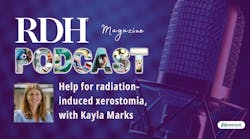A mom's quest to ease her son's oral pain during cancer treatment
Laraine Hartles's career took an unexpected turn when she received a life-altering call from her husband. He was at the doctor’s office with their seven-year-old son, who had been experiencing minor health issues. The doctor recommended further testing at the children’s hospital.
After several anxiety-filled days, their son was diagnosed with a rare and aggressive cancer known as "tumors of the small round blue cell (SRBC)." This undifferentiated soft-tissue cancer had limited research at the time, with studies primarily taking place in France. Due to the lack of specific treatment protocols, oncologists treated it as Ewing’s sarcoma, the closest known match based on cell type and growth pattern.
His chemotherapy plan targeted rapidly regenerating cells, including those in the mucous membranes and oral cavity. Initially, Laraine was only warned about the possibility of "mouth sores," leading her to believe they were a minor side effect that could be managed as they appeared. However, she soon realized the impact of cancer treatment on oral health is far more extensive. Prevention would be just as critical as treatment.
A mom steps in to help with oral care
Leveraging her expertise as a dental hygienist, she became very proactive in managing her son's oral care, which helped minimize his oral discomfort significantly.
One of the most debilitating side effects he faced was oropharyngeal mucositis, a painful condition that can lead to dehydration, poor nutrition, and weight loss. Over the course of 18 months of treatment, he experienced these complications repeatedly. Oropharyngeal mucositis is inflammation of the oropharyngeal mucosa, typically presenting as atrophy, swelling, erythema, and ulceration. Microscopically, the condition results from DNA damage to the basal cell layer of the epidermis, making it an extremely painful and challenging side effect.
Symptoms for oral mucositis typically appear one to two weeks after treatment. By that time, patients or caregivers may not immediately associate the cause with the symptoms, which makes early education and preventive intervention essential.
Approximately 20%–40% of patients undergoing chemotherapy develop mucositis, and this percentage rises to 60%–85% among head and neck cancer patients who receive both chemotherapy and radiation.1,2 The severity is classified on a scale from 1 (mild) to 4 (severe), with the most extreme cases potentially causing interruptions in treatment until symptoms subside.3
Laraine had to become an advocate for her son's oral care, sharing the successes of minimizing oral mucositis during his treatment. She often found herself more informed than the medical teams about treatments they did not prescribe or suggest—interventions that ultimately proved most beneficial. Her son's lack of oral discomfort surprised many doctors and nurses, as severe mucositis is typically expected in chemotherapy patients.
When consulting with hospital nurses, radiation nurses, and oncologists, the discussions primarily focused on preventing bacterial overgrowth and keeping oral tissues well-hydrated. However, through her own research, she discovered several additional recommendations that were not being routinely advised.
One key resource she found was the Mucositis Study Group of the Multinational Association of Supportive Care in Cancer/International Society of Oral Oncology (MASCC/ISOO). This organization comprises clinicians from various disciplines, including dentistry, nursing, and hematology, who collaborate to review evidence and provide guidelines for managing oral mucositis.
In 2020, the MASCC/ISOO reviewed the latest research and offered several evidence-based strategies to prevent or reduce the severity of oral mucositis. Many of these recommendations were successfully incorporated into her son’s care, significantly reducing the severity of his oropharyngeal mucositis.4
Laraine’s insights for oral care during cancer treatment
Here are several of Laraine’s firsthand accounts that demonstrate how she delivered thorough home care grounded in evidence for preventing or reducing the severity of oropharyngeal mucositis.
Basic oral care: Brushing and cleaning in between is vital in controlling the biofilm, which maintains the oral microbiome. Performing oral hygiene aids in reducing secondary infections such as pneumonia, or those of viral or fungal forms.3 Recent studies have reported less severity and duration of mucositis with a more resilient oral microbiome.5 Encouragement from caregivers and loved ones to take care of their oral health is another way to help those going through cancer therapies. Daily biofilm control and use of xylitol reduces the spread of the caries-causing bacteria.6
Toothbrushing: Gently use the softest bristle toothbrush possible two to three times per day after eating.7 With my knowledge of biofilm control I used a brush with silver-infused bristles called Mouthwatchers. These were introduced to us by a dentist who recommended them to his periodontal patients to help with bacterial reduction. This toothbrush contains soft, thin, polyester bristles that are 10 times smaller than most ordinary toothbrush bristles and may have been the reason for bacterial reduction. The bristles are soft enough and thin enough to allow my son to brush longer and more effectively. Currently, studies don’t show solid evidence that they work to greatly reduce bacteria in the oral cavity.
Another option was a toothbrush with charcoal bristles. The mean CFU (colony-forming unit) count for noncharcoal bristles was almost double that of charcoal bristles.8 Overall these bristles are shown to harbor less bacteria, which could contribute to a more resilient microbiome. At times my son couldn’t tolerate even a toothbrush due to the pain from mucositis, so we used a foam sponge swab dipped in either diluted toothpaste or a mouth rinse. The foam sponge was less irritating than the nylon bristles and worked to give some biofilm disruption.
Toothpaste: The Oral Cancer Foundation recommends using mild tasting toothpastes with fluoride, such as biotene enzyme-based products, as some flavorings and foaming agents such as SLS (sodium lauryl sulfate) in toothpaste may irritate the mouth. When toothpaste was still too irritating, we used a solution made by dissolving one teaspoon of salt in four cups of water, or mixing one teaspoon baking soda in two cups of water.7 We consistently used the prescription-strength fluoridated toothpastes; they were gentle enough and effective in keeping him cavity-free during his entire cancer journey.
Cleaning in between teeth: As floss snaps interproximally, it can be very painful when ulcerations are present, also, patients may have a hard time opening. So, for cleaning interproximally, a water flosser that can adjust the water flow makes this more comfortable. Water flossers are as efficient as regular floss in removing interdental plaque on single use. 9
Rinses: If mucositis is present, avoid rinsing with alcohol-based rinses as this can be very irritating. I did find that the use of hydrogen peroxide-based rinses such as Peroxyl coated the tissues. The taste was mild and did not seem to cause the burning that some other brands did. The MASCC/ISOO removed chlorhexidine (CHX) from its list of recommendations, referencing insufficient evidence of clinical benefits and possible negative effects such as changes in taste. Also, there are no studies that prove the effectiveness of using CHX alone in the clinical course of mucositis. Knowing the importance of the oral microbiome, some rinse may induce stress on the microbial environment by depleting commensal (beneficial) microbes.2
Povidone iodine rinse: This is a broad-spectrum antimicrobial agent that destroys bacteria, virus, fungi, and protozoa. It reduces plaque formation, decreases the severity of gingivitis, and reduces caries. It also has anti-inflammatory effects that have been proven to inhibit inflammation arising from the host response.10 When used as a diluted 1%–.5% rinse, it also reduces the incidence, severity, and duration of oropharyngeal mucositis.11 It can be purchased over the counter and used as a cost-effective and safe prophylactic method of treatment.
Overall, it’s vital to find ways to increase the frequency of oral hygiene regimens in a gentle way to avoid further trauma to the tissues. Increased bacterial counts and a weakened immune system increase the likelihood for mucositis. The nurses who regularly assessed for the presence of ulcers or signs of lesions in my child's mouth recommended that I be vigilant at home with a flashlight to look for signs of any type of cut, redness, ulceration, or patchy mucosa.
Not the outcome they hoped for
After a courageous 18-month battle, my son passed away due complications from the metastasis of cancer into his lungs. The treatment he underwent, and the experience we had, involved endurance and a journey of learning. My goal now is to continue to share the experience of what I learned with others to improve the outcomes for those with side effects during their cancer therapy.
Authors' note: We would like to dedicate this article in loving memory of Owen Hartle, 2005-2014.
References
1. Pulito C, Cristaudo A, Porta CL, et al. Oral mucositis: the hidden side of cancer therapy. J Exp Clin Cancer Res. 2020;210(39). doi:10.1186/s13046-020-01715-7
2. Liu YC, Wu CR, Huang TW. Preventive effect of probiotics on oral mucositis induced by cancer treatment: a systematic review and meta-analysis. Int J Mol Sci. 2022;31;23(21):13268. doi:10.3390/ijms232113268
3. Bell A, Kasi A. Oral mucositis. StatPearls. January 2023. Updated May 29, 2023. https://www.ncbi.nlm.nih.gov/books/NBK565848/
4. Elad S, Cheng KKF, Lalla RV, et al: MASCC/ISOO clinical practice guidelines for the management of mucositis secondary to cancer therapy. Cancer. 2020;126(19):126:4423-4431. doi:10.1002/cncr.33100
5. Bruno JS, Al-Qadami GH, Laheij AMGA, Bossi P, Fregnani ER, Wardill HR. From pathogenesis to intervention: the importance of the microbiome in oral mucositis. Int J Mol Sci. 2023;5;24(9):8274. doi:10.3390/ijms24098274
6. Nayak PA, Nayak UA, Khandelwal V. The effect of xylitol on dental caries and oral flora. Clin Cosmet Investig Dent. 2014;10(6):89-94. doi:10.2147/CCIDE.S55761
7. Information and resources about oral head and neck cancer. Oral Cancer Foundation. March 16, 2023. https://oralcancerfoundation.org/complications/mucositis
8.Thamke MV, Beldar A, Thakkar P, Murkute S, Ranmare V, Hudwekar A. Comparison of bacterial contamination and antibacterial efficacy in bristles of charcoal toothbrushes versus noncharcoal toothbrushes: A microbiological study. Contemp Clin Dent. 2018;9(3):463-467. doi:10.4103/ccd.ccd_309_18
9. Abdellatif H, Alnaeimi N, Alruwais H, Aldajan R, Hebbal MI. Comparison between water flosser and regular floss in the efficacy of plaque removal in patients after single use. Saudi Dent J. 2021;33(5):256-259. doi:10.1016/j.sdentj.2021.03.005
10. Kanagalingam J, Chopra A, Hong MH, Ibrahim W, Villalon A, Lin JC. Povidone-iodine for the management of oral mucositis during cancer therapy. Oncol Rev. 2017;11(2):341. doi:10.4081/oncol.2017.341
11. Jyothi, Latha S, Pavithra K, Nalini M, Rao SJ, Mamatha B. Effect of povidone iodine versus chlorhexidine mouthwash on oral mucositis among cancer patients. J Clin of Diagn Res. 2021;15(9):XC09-XC12. https://jcdr.net/articles/PDF/15429/46216_CE[Ra1]_F(SHU)_PF1_(AB_SK)_PFA(AB_SL_KM_AnK)_PN(SS).pdf
About the Author

Shelley Brown, MEd, BSDH, RDH
Shelley is a dental educator, speaker, content creator, and mobile clinician dedicated to advancing accessible and innovative dentistry. As co-owner of HYGIENE edgeUCATORS, she empowers dental educators through professional development. Since 2009, she has taught at the Utah College of Dental Hygiene and founded Homebound Smiles, a mobile dental practice serving underserved patients. She also runs Shelley.Dental, a YouTube and TikTok platform focused on patient education and minimally invasive dentistry.

Laraine Hartle, BSDH, RDH
Laraine has more than 14 years of experience as a hygienist and dental hygiene educator. She’s committed to maintaining oral health and educating others about the oral-systemic connection. She’s a clinical instructor at Utah College of Dental Hygiene. Laraine's deep understanding of the oral-systemic health connection drives her mission to educate patients and students about the importance of oral health to overall wellness. She co-owns Glam Studio Pros, a teeth whitening and piercing studio. Visit linkedin.com/in/laraine-hartle-rdh and @laraine_rdh and @glamstudiopros.


